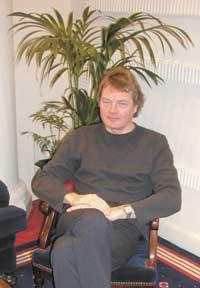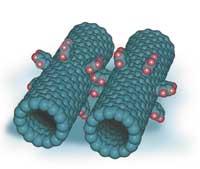James Gimlewski: "With the mechanical properties of with the mechanical properties of molecules"

He worked at IBM in Zurich and then left Los Angeles at UCLA. How has your work been in these laboratories?
Yes, I worked in the Zurich laboratory since 1983, when the tunnel-effect microscope was developed. Since then I have researched the science of nanoscale. Then, in February 2001, I went to California to work at UCLA and the California Institute of Nanosystems. The institute has been launched between UCLA and the University of Santa Barbara. This is a $200 million project.
In the Zurich laboratory, IBM developed a project to move atoms by one through the tunnel-effect microscope. Did you participate in this project?
Yes. The tunnel effect microscope was developed by physicists Heinrich Rohrer and Gerd Binnig, obtaining the "visualization" tool of the atom. In addition, it was proven that this instrument has the ability to move atoms. In that framework I began to participate.
At first I got involved in complex molecule design projects. They are molecules of about 150 atoms. We manipulate them in many ways: we can place them where we want, we can change their appearance, etc.
Later I started working with fulerenes, with these 60 carbon cages. For the elaboration of the chips it is intended to prepare chemical reactions that bind the components by natural assembly; the fulerenes would be the precursors of these reactions. But that's just part of my research.
How do you define nanotechnology?
It is a very broad concept. Nanotechnology is a combination of processes of biochemistry, chemistry, electricity and nanometer scale engineering, consisting of systems technology of at least one (approximate size of three atoms) and a maximum of 100 nanometers (about one-fifth of a hair thickness). These processes determine the characteristics of matter, but the systems are very complex.
The first biological systems of understanding nanomechanics, the basis of many of them, can be studied. For example, the DNA chains within the stem cells are also stored in the nucleus, to which structures similar to the springs are attached. These 'springs' can be chemically modified in a controlled manner, adapting the DNA topology and causing the expression of the genes of the desired shape. As a result, we could transform stem cells into liver, kidney cells… into the desired type of cells.
On the other hand, if it is possible to design systems with silicon micromechanics that contain a fortnight of the thickness of a hair, nanomechanical motion sensors can be made according to their biochemical characteristics. Finally, a stack of medium complexity molecular systems can mechanically modify other molecules. The general idea seems very interesting to me because through electron currents and mechanical properties many things can be done. So far little research has been done on this idea.
Some news reports mention lubricants for nanomachines. Is mechanical friction generated in these nanoscale machines?
In classical friction two contiguous objects touch each other and interactions between wrinkles present on surfaces are created. These interactions are interelectronic, but can appear from a macroscopic point of view through the force of friction.
In nanomechanics interactions between electrons of two molecules can also hinder movement, but there are no "macroscopic frictions". To overcome these drawbacks, if between these two molecules comes another one that does the wheel function, even if it does not have a classical friction, the interaction of the wheel and the other molecule can be treated as a stream of electrons. They are interactions based on the energy levels of both systems, as well as those that control the chemical bonds and forces of Van der Waals. We have to develop new ideas in this type of systems, but in the end there is a resistance force, in short, we have to overcome the energy barrier of rotation. If the barrier is below thermal energy, movement will occur.

On the other hand, when it comes to locating simple atoms in a certain place, is not the interaction between electrons an advantage?
Yes, these processes are very useful, especially at low temperatures. Thermal energy is low and atomic force is high. So you can catch an atom. At room temperature, however, it is only possible to push the molecules, as they do not support the microscope needle.
On their website you have an online documentary on nanotechnology in which you can see how glow moves on a surface. You do these experiments at room temperature.
Yes. I knew that the tunnel effect microscope at low temperatures at 4K (-269ºC) was used in UCLA laboratories. Instead, I wanted to analyze how molecules act in the usual conditions in which we live and how they can change. On the other hand, working at low temperatures is a number of advantages since certain molecules are not easy to handle.
In your experiment you managed to change the appearance of the Fulerenes. How is it done?
The electronic structure of fulerenes is very curious. They are large surface spheres and empty energy levels allow interaction with other molecules from that surface. From the microscope needle to this surface the electrons are transported by the tunnel effect, but the molecule, mechanically pressed, can change its appearance. This modifies the symmetry of the molecule and therefore the energy levels, modifying the tunnel effect current.
This means that in this way forces of some nanonewtones can be detected, that is, one billion a newton, a force capable of compressing a fulerene (note that a newton is the necessary force to maintain a weight of about one kilo). This small force causes a large change in the electron current of the microscope. Therefore, our intention is to design an electromechanical amplifier, amplified by the appearance of molecules. In addition, it is a reversible process.

Have you performed any experiments inside a fulerene with an atom?
We have never placed atoms within fulerenes C 82 (larger than conventional ones). Atoms are not located in the center, as this is not a minimum energy location, but it is estimated that there are three minimum energy locations. We want to know if in this type of systems the inner atom can vary from one location to another in a controlled way and if this change affects the electron current of the microscope. I don't think the idea has been successful because at room temperature it is very difficult for the atom to remain in one position, but the idea seems very interesting to me. By ordering a stack of such systems on a surface, it is possible that a memory chip can be made in which each bit is not binary but ternary. The chip would be very small.
You have also performed single-electron experiments. How do you get a single electron to participate in an experiment?
They are usually made by small biomolecules. These biomolecules can receive an electron and, when this happens, their energy changes. However, as a result of this change, the molecule cannot receive more electrons and therefore serves to perform single-electron processes for the manufacture of nanotransistors and biochip components.
Buletina
Bidali zure helbide elektronikoa eta jaso asteroko buletina zure sarrera-ontzian











